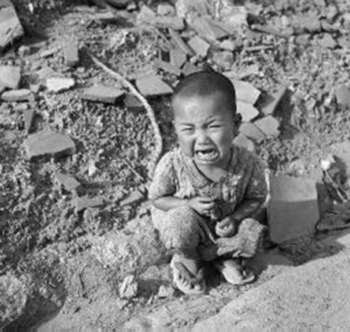"It adds evidence to the fact that radiation even at moderately low doses is hazardous, and the diseases you can get aren't only cancers," said David J. Brenner, who heads the Center for Radiological Research at Columbia University in New York, and was not involved in the study.
The Japanese researchers focused on so-called myelodysplastic syndromes, or MDS, in which damage to cells in the bone marrow prevents blood cells from developing properly.
40 years later, Nagasaki bomb still causes disease
 With a baseline rate of only a dozen MDS cases per 100,000 survivors per year, Brenner added, even an eight-fold increase in risk doesn't amount to much.
With a baseline rate of only a dozen MDS cases per 100,000 survivors per year, Brenner added, even an eight-fold increase in risk doesn't amount to much.
"This is quite a small risk relative to getting the common cancers," he said.
The findings nevertheless may add to ongoing debate over modern radiation sources, such as computed-tomography (CT) scanning, a high-resolution form of x-ray.
About one in three Americans develop some type of cancer during their lives, and researchers have worried the recent upswing in CT scans performed for a variety of reasons could drive the number even higher.
Although newer CT machines have significantly reduced the amount of x-ray radiation patients receive, a handful of average scans is still enough to land patients in the same exposure category as Nagasaki survivors living a couple miles from where the bomb landed. Whether that raises their risk of disease remains unclear.
According to a 2009 study from the National Cancer Institute, it takes 1,000 CT scans to cause a case of cancer in a 50-year-old. So experts agree that under appropriate circumstances, the benefits far outweigh the harms.
The new study looked at more than 86,000 Nagasaki survivors, 198 of whom developed MDS between 1985 and 2004. However, the Japanese researchers couldn't pick up cases that happened before that.
They found the disease risk rose by between 70 and 88 percent for each kilometer (about 0.6 miles) closer the survivors had lived to the blast.
 Among those survivors who had received the highest dose of radiation - more than one gray, the equivalent of a few hundred standard CT scans - 81 per 100,000 per year got MDS. Among those exposed to the equivalent of about one CT scan, the rate was about 11 MDS cases per 100,000. That's within the range in the general population.
Among those survivors who had received the highest dose of radiation - more than one gray, the equivalent of a few hundred standard CT scans - 81 per 100,000 per year got MDS. Among those exposed to the equivalent of about one CT scan, the rate was about 11 MDS cases per 100,000. That's within the range in the general population.
Rebecca Smith-Bindman of the University of California, San Francisco, noted that people with MDS are at very high risk of developing leukemia, adding that the new study was the first to show radiation could cause MDS decades later.
"The work highlights another harm of radiation and should increase our efforts to reduce radiation exposure to the degree possible,"
The Japanese researchers focused on so-called myelodysplastic syndromes, or MDS, in which damage to cells in the bone marrow prevents blood cells from developing properly.
40 years later, Nagasaki bomb still causes disease
 With a baseline rate of only a dozen MDS cases per 100,000 survivors per year, Brenner added, even an eight-fold increase in risk doesn't amount to much.
With a baseline rate of only a dozen MDS cases per 100,000 survivors per year, Brenner added, even an eight-fold increase in risk doesn't amount to much."This is quite a small risk relative to getting the common cancers," he said.
The findings nevertheless may add to ongoing debate over modern radiation sources, such as computed-tomography (CT) scanning, a high-resolution form of x-ray.
About one in three Americans develop some type of cancer during their lives, and researchers have worried the recent upswing in CT scans performed for a variety of reasons could drive the number even higher.
Although newer CT machines have significantly reduced the amount of x-ray radiation patients receive, a handful of average scans is still enough to land patients in the same exposure category as Nagasaki survivors living a couple miles from where the bomb landed. Whether that raises their risk of disease remains unclear.
According to a 2009 study from the National Cancer Institute, it takes 1,000 CT scans to cause a case of cancer in a 50-year-old. So experts agree that under appropriate circumstances, the benefits far outweigh the harms.
The new study looked at more than 86,000 Nagasaki survivors, 198 of whom developed MDS between 1985 and 2004. However, the Japanese researchers couldn't pick up cases that happened before that.
They found the disease risk rose by between 70 and 88 percent for each kilometer (about 0.6 miles) closer the survivors had lived to the blast.
Rebecca Smith-Bindman of the University of California, San Francisco, noted that people with MDS are at very high risk of developing leukemia, adding that the new study was the first to show radiation could cause MDS decades later.
"The work highlights another harm of radiation and should increase our efforts to reduce radiation exposure to the degree possible,"
0 comments:
Post a Comment
please leave your opinion about his blog ,
this will help us to give some more quality information.